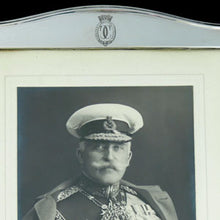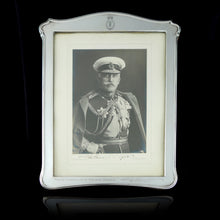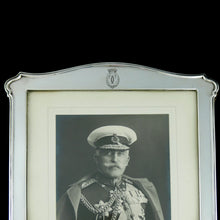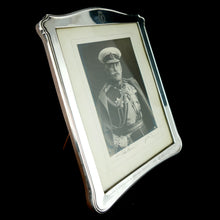Royal Presentation Portrait Photograph of Arthur, Duke of Connaught, 1923
Adding product to your cart
24cm (9.5in) x 19cm (7.5in)
Silver. Half length portrait by W&D Downey of Ebury Street, London, showing Prince Arthur in Field Marshal’s unform and open great coat draped about the shoulders. Signed in the lower mount in ink in the Duke’s hand ‘Arthur - 1923’. The frame with curved top engraved with entwined C cypher encircled by the Garter and surmounted by the coronet of a prince of the blood. The frame further engraved the name of the Empire’s pageant master ‘Frank Lascelles of Sibford Gower’ and the Dukes facsimile autograph ‘Arthur’. Maker’s mark to frame of A&J Zimmnerman. Hallmarked 1922.
Read more
Prince Arthur, 1st Duke of Connaught and Strathearn, was the third son and seventh of the nine children of Queen Victoria and Prince Albert. He had a long and distinguished career in the British Army that included service in South Africa, Canada, Ireland, Egypt and India. Promoted to Field Marshal in 1902, in 1904 he was given the newly created post of Inspector-General of the Forces and was tasked with reporting on the status of the British Army. He was subsequently unwillingly sent to Malta as Commander-in-Chief; he resigned the position in 1909. Having ended his military service he was appointed Governor General of Canada in 1911.

Frank William Thomas Charles Christian Culpeper Lascelles (1875-1934) first came to the fore as a budding thespian with Oxford University’s Dramatic Society and afterwards with Sir Herbert Beerbohm Tree’s company at His Majesty’s Theatre in London. Influenced by Tree’s use of pageant-like scenes in his Shakespearean productions, Lascelles staged his first historical pageant in Oxford in 1907. Despite initial reservations by the University authorities and a student riot, it was highly successful and led to the organisation of many such events over the next twenty-five years, including a celebration to mark the inaugural Opening of Parliament in South Africa (1909), the Coronation Durbar in Calcutta (1912) involving some 300,000 participants and an imperial pageant at the British Empire Exhibition at Wembley (1924). As a sculptor Lascelles’ output included portrait busts of Edward, Prince of Wales, the Duke of Connaught and the Aga Khan III. He further sculpted a memorial to his mother in the church at Sibford Gower where he built himself a manor house. Lascelles was unmarried and entertained lavishly. His end, however, was pitiful, dying in poverty and sickness in a Brighton boarding-house, having given away more than he could afford. He asked the artist Frank Brangwyn to administer his estate and fund a 'school of nations' for children from all over the world to promote world peace and understanding, but his wealth was wholly inadequate.










